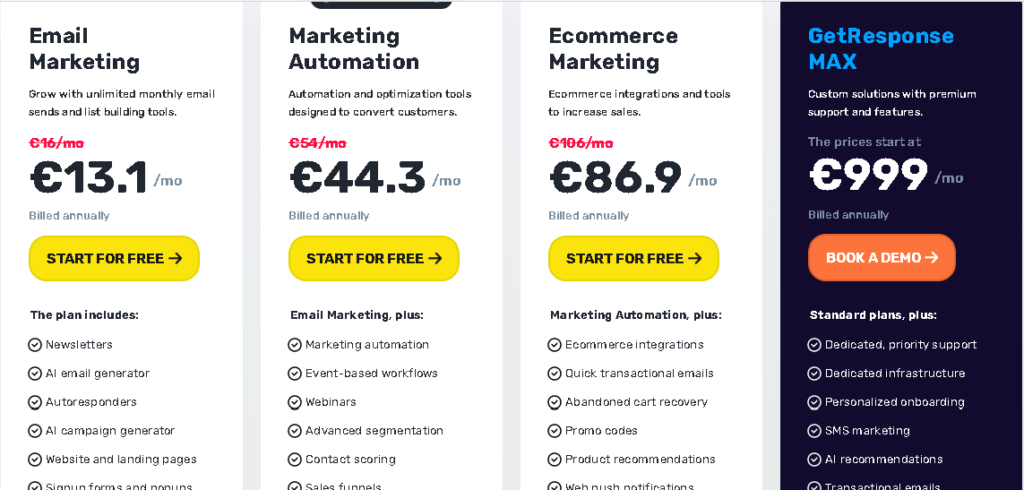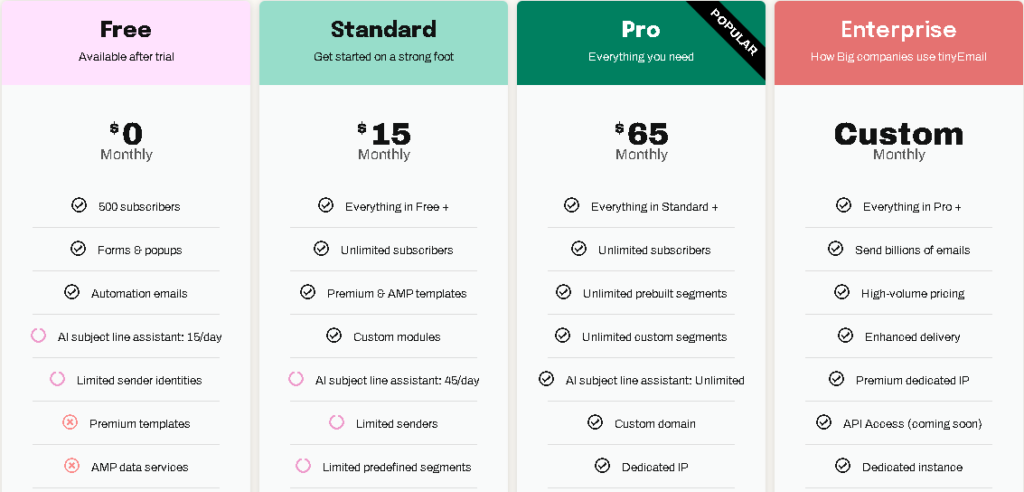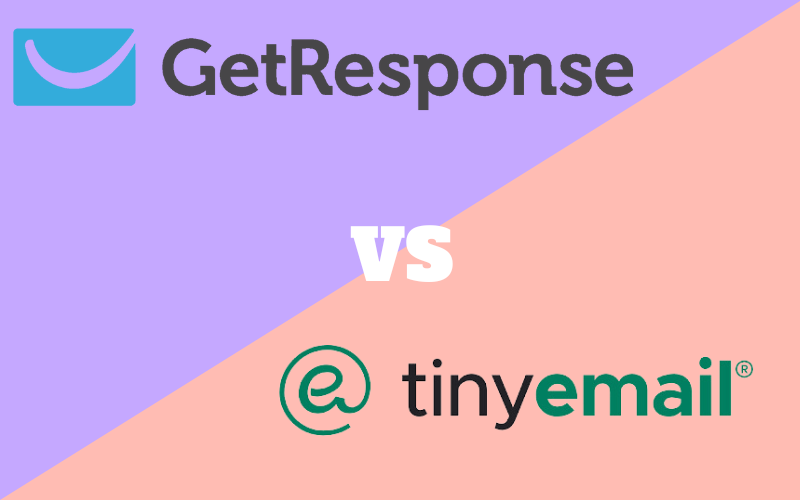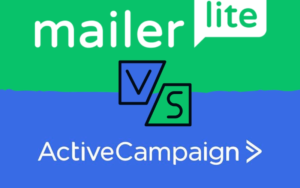We may earn money from the companies mentioned in this post. Your purchase won't cost you any extra, but it helps support the content and upkeep of this website. Thank you!
In the ever-evolving domain of email marketing, choosing the right platform can significantly propel your marketing efforts. Today, we delve into a detailed comparison of two notable platforms in the industry: GetResponse and tinyEmail. Our in-depth examination aims to shed light on the GetResponse vs tinyEmail debate, exploring their features, usability, pricing, and much more. Through this analysis, we aspire to provide you with a clear perspective to make an informed choice that aligns with your marketing objectives and budgetary constraints. Whether you’re a small business owner, a seasoned marketer, or someone venturing into email marketing, this comparison will serve as a valuable resource in your quest for the ideal email marketing platform.
Table of Contents
Overview of GetResponse and tinyEmail
In the bustling market of email marketing platforms, GetResponse and tinyEmail have carved a niche for themselves. Both tools come with a robust set of features designed to help businesses communicate effectively with their audience. Let’s delve into an in-depth overview of GetResponse and tinyEmail, shedding light on their capabilities and how they stack up against each other.
GetResponse: An Integrated Marketing Solution
GetResponse is more than just an email marketing tool; it’s an integrated solution designed for businesses looking to supercharge their marketing efforts. With GetResponse, you can create captivating email campaigns, build landing pages, host webinars, and even manage your CRM activities. It’s a multi-faceted platform that aims at being a one-stop-shop for all your marketing needs.
The platform provides a user-friendly interface with intuitive navigation, making it a breeze for users to find what they are looking for. The drag-and-drop editor is a standout feature, simplifying email creation to a few clicks and drags. Moreover, with its automation capabilities, you can set up sophisticated marketing funnels to nurture leads and boost engagement.
tinyEmail: The Simplified Email Marketing Tool
tinyEmail, as the name suggests, takes a minimalist approach to email marketing. It sticks to the core functionality, ensuring that creating and sending emails is a straightforward process. If you are a small business owner or a solopreneur, tinyEmail might be the streamlined solution you need to get your email marketing off the ground without a steep learning curve.
With TinyEmail, you get a clean, uncluttered interface that allows you to focus solely on crafting your messages. While it may lack some of the bells and whistles of more comprehensive platforms like GetResponse, it makes up for it with its ease of use and no-nonsense approach to email marketing.
GetResponse vs tinyEmail: Tailored to Different Needs
The comparison between GetResponse and tinyEmail ultimately boils down to the scope and complexity of your marketing needs. GetResponse is a robust, all-encompassing platform that caters to a variety of marketing tasks beyond just email. On the flip side, tinyEmail keeps things simple and straightforward, ideal for individuals or small businesses focusing solely on email marketing.
In essence, whether you lean towards GetResponse or tinyEmail will depend on your marketing ambitions. Both platforms are competent in their realms, but your individual or business needs will dictate which one aligns better with your goals. Through this comparison, we aim to provide you with a clear picture, helping you make an informed decision in the GetResponse vs tinyEmail debate.

Ease of Use
When diving into the world of email marketing, the ease of using a platform is a paramount concern. Today, we’ll compare the user-friendliness of GetResponse and tinyEmail to see which one gets the upper hand in the “Ease of Use” department. Our comparison will cover the user interface, signup and setup process, as well as the learning curve associated with each platform.
User Interface Comparison
The user interface is the first thing you notice when you log into an email marketing platform. It’s like the dashboard of a car, having all the controls you need at your fingertips.
GetResponse:
GetResponse boasts a modern and intuitive interface. With its clean design, navigating through the platform is a breeze. The dashboard is organized logically, making it easy to find the features you need. The drag-and-drop editor for email creation is a highlight, simplifying the process of crafting beautiful emails. It would be beneficial to include a screenshot of the GetResponse dashboard here to provide a visual aid to the readers.
tinyEmail:
On the other hand, tinyEmail adopts a minimalist approach with a straightforward interface. It might lack the sleek appearance of GetResponse, but it gets the job done efficiently. Those who appreciate a no-nonsense, functional layout will find tinyEmail appealing. A screenshot of the tinyEmail dashboard can also be inserted here for a side-by-side comparison with GetResponse.
Signup and Setup Process
Getting started with a new platform can either be a walk in the park or a hurdle race. Let’s see how GetResponse and tinyEmail fare.
GetResponse:
The signup process for GetResponse is straightforward. It requires basic information and a few minutes to get you onboard. Once signed up, a helpful setup wizard guides you through the initial setup, making the process smooth even for beginners. An image of the setup wizard can be added here to illustrate the ease of setup.
tinyEmail:
tinyEmail, on the other hand, has a quick signup process too. However, it skips on a setup wizard, which might leave some new users hanging. The setup is fairly intuitive, but a step-by-step guide could be a nice addition to ensure everyone hits the ground running.
Learning Curve
No one wants to spend days or weeks learning how to use a new tool. The shorter the learning curve, the faster you can get your email campaigns rolling.
GetResponse:
With GetResponse, the learning curve is quite gentle. The platform offers a plethora of tutorials, webinars, and a knowledge base to get you acquainted with all its features. For visual learners, a video tutorial showcasing the basic features could be embedded here.
tinyEmail:
tinyEmail, keeping with its minimalist ethos, is easy to get the hang of, although it lacks the extensive educational resources that GetResponse offers. However, its straightforward functionality ensures you won’t be left scratching your head for too long.
In conclusion, both GetResponse and tinyEmail shine in their own light when it comes to ease of use. Your preference between a modern intuitive interface or a simple, straightforward one will likely steer your choice between these two platforms. Plus, the support and educational resources offered by GetResponse can be a boon for newcomers to email marketing.
Email Campaign Creation
Creating compelling email campaigns is at the heart of effective email marketing. Both GetResponse and tinyEmail offer tools and features to aid you in this endeavor. In this section, we’ll delve into the email campaign creation capabilities of each platform, focusing on their drag-and-drop editors, template variety, and customization capabilities. Our goal is to provide a clear insight into the GetResponse vs tinyEmail narrative in terms of crafting email campaigns.
Drag-and-Drop Editor Comparison
The drag-and-drop editor is a pivotal feature as it directly impacts the ease of creating emails. A good editor can significantly reduce the time and effort required to create stunning email campaigns.
GetResponse:
GetResponse boasts a highly intuitive drag-and-drop editor that makes email creation a breeze. The editor is robust, allowing for a wide range of customization that can cater to both beginners and more advanced users. It’s easy to add text, images, buttons, and even social media links with just a few clicks and drags.
tinyEmail:
tinyEmail, on the other hand, provides a simpler drag-and-drop editor. It’s straightforward and gets the job done with minimal fuss. While it may not have as many bells and whistles as GetResponse, it’s perfect for those who prefer a no-nonsense approach to email creation.
Template Variety and Quality
A diverse range of templates can be a great starting point for your email campaigns, saving time and inspiring creativity.
GetResponse:
GetResponse offers a plethora of professionally designed templates. Whether you’re looking to send newsletters, promotional emails, or anything in between, you’ll likely find a template that fits the bill. The quality of templates is high, ensuring your emails look professional and engaging.
tinyEmail:
tinyEmail has a more modest selection of templates. The available options are simple, clean, and effective, making them a good starting point for basic email campaigns.
Customization Capabilities
Being able to customize your emails to align with your brand and message is crucial. Let’s see how these platforms fare in this regard.
GetResponse:
GetResponse shines in terms of customization. The platform allows for a high degree of personalization, enabling you to tweak templates or build emails from scratch to match your brand aesthetics.
tinyEmail:
tinyEmail, while not as versatile, still offers a decent level of customization. You can adjust colors, fonts, and images to reflect your brand, though the options are more limited compared to GetResponse.
When it comes to email campaign creation, both GetResponse and tinyEmail have their merits. GetResponse stands out with its robust editor and wide template variety, making it a suitable choice for those looking to craft more complex, personalized emails. On the flip side, tinyEmail’s simplicity and straightforward approach make it a solid choice for individuals or small businesses focusing on creating simple, effective email campaigns. The comparison of GetResponse vs tinyEmail in this realm boils down to your specific needs and the level of customization you require for your email marketing endeavors.
Automation Features
Automation is the linchpin of effective email marketing, allowing for timely and relevant communication with your audience without manual intervention. In this segment, we’re diving into the automation features of GetResponse and tinyEmail, examining their automation workflows, autoresponder functionality, and event-triggered email capabilities. Our exploration aims to shed light on the GetResponse vs tinyEmail narrative from the automation standpoint.
Automation Workflow Comparison
Automation workflows are sequences of actions and triggers that automate your email marketing tasks. Let’s compare how GetResponse and tinyEmail facilitate this.
GetResponse:
GetResponse provides a visual automation builder that’s both powerful and intuitive. You can create complex automation workflows by simply dragging and dropping elements within the builder. Whether it’s sending emails, tagging contacts, or moving them between lists, GetResponse covers a broad spectrum of automation possibilities.
tinyEmail:
tinyEmail offers a more basic automation setup. It’s straightforward, making it easy for beginners to set up simple automation workflows. While it may lack the extensive features of GetResponse, it’s suitable for basic automation needs.
Autoresponder Functionality
Autoresponders are crucial for sending timely follow-up emails or welcome messages to your subscribers.
GetResponse:
GetResponse’s autoresponder is feature-rich, allowing for time-based and action-based responses. You can schedule emails for specific dates or trigger them based on user actions, ensuring your audience receives relevant emails at the right time.
tinyEmail:
tinyEmail’s autoresponder functionality is more limited but still effective for basic needs. You can set up welcome emails and other simple autoresponders with ease.
Event-Triggered Email Capabilities
Event-triggered emails are sent based on specific actions taken by your contacts, enhancing engagement and relevance.
GetResponse:
GetResponse excels in this area, offering a variety of triggers such as email opens, clicks, and completed transactions. This feature allows for highly targeted and timely email campaigns.
tinyEmail:
tinyEmail, while having basic event-triggered email capabilities, doesn’t offer as wide a range as GetResponse. However, it covers the basics, enabling simple yet effective automated engagement with your audience.
In the realm of automation, GetResponse clearly has an upper hand with its extensive features and intuitive interface. It’s well-suited for businesses with more complex automation needs. tinyEmail, with its simpler approach, caters to those looking for basic automation solutions. The GetResponse vs tinyEmail comparison in terms of automation portrays a scenario of comprehensive vs. simplified, and your choice would hinge on the complexity of your automation requirements.
Contact Management
Effective contact management is the cornerstone of personalized and targeted email marketing. In this section, we’ll delve into how GetResponse and tinyEmail fare in managing contacts, from importing and organizing contacts to segmentation and tagging. This exploration is pivotal in the GetResponse vs tinyEmail debate as it affects how well you can tailor your campaigns to your audience.
Contact Import and Organization
Importing and organizing your contacts efficiently is the first step towards successful email marketing.
GetResponse:
GetResponse provides a seamless experience for importing contacts. You can upload your contact lists via CSV, TXT, VCF, or directly from third-party services. Once imported, organizing your contacts is straightforward with the option to create multiple lists and custom fields for better management.
tinyEmail:
tinyEmail also facilitates easy contact import through CSV files. The organization is fairly simple with a basic interface that allows for list creation and contact management, though it lacks some of the advanced organization features of GetResponse.
Segmentation Capabilities
Segmentation is key for targeting different groups within your audience based on specific criteria.
GetResponse:
GetResponse shines in segmentation with a robust feature set allowing for highly detailed segmentation based on various criteria like location, engagement levels, and custom fields. This flexibility enables more targeted campaigns.
tinyEmail:
tinyEmail offers basic segmentation features, allowing you to divide your audience based on fundamental criteria. While not as extensive as GetResponse, it covers the basics effectively.
Tagging and Scoring
Tagging and scoring are advanced features that further refine how you manage and engage with your contacts.
GetResponse:
GetResponse offers tagging to categorize contacts and scoring to prioritize them based on their engagement and other behaviors. These features provide a granular level of control in managing your audience.
tinyEmail:
tinyEmail has a simpler tagging system and lacks a scoring feature. It’s suitable for basic tagging needs but may fall short for more advanced audience management.
In the realm of contact management, GetResponse offers a more advanced and flexible system compared to tinyEmail. From importing and organizing contacts to segmentation, tagging, and scoring, GetResponse provides a comprehensive suite of tools for sophisticated contact management. On the other hand, tinyEmail keeps things simple and straightforward, catering to basic contact management needs. Your choice between GetResponse vs tinyEmail in this aspect will largely depend on the complexity of your contact management requirements and the level of personalization you aim to achieve in your email campaigns.
Analytics and Reporting
In the digital marketing realm, data is king. Understanding the performance of your email campaigns is crucial for making informed decisions and optimizing your strategy. This segment will dive into the analytics and reporting features of GetResponse and tinyEmail, exploring the metrics tracked, the reporting interface, and real-time analytics capabilities. The comparison sheds light on the GetResponse vs tinyEmail scenario, highlighting how each platform empowers you with data.
Metrics Tracked
Keeping a tab on key metrics is essential to gauge the effectiveness of your email campaigns.
GetResponse:
GetResponse provides a comprehensive suite of metrics including open rates, click-through rates, bounce rates, unsubscribe rates, and more. Additionally, it offers social sharing statistics, and eCommerce tracking, providing a well-rounded view of your campaign performance.
tinyEmail:
tinyEmail offers basic yet essential metrics like open rates, click rates, and bounce rates. Although not as extensive as GetResponse, it covers the foundational metrics necessary for analyzing campaign effectiveness.
Reporting Interface
A user-friendly reporting interface is crucial for easily interpreting data and deriving actionable insights.
GetResponse:
GetResponse boasts a visually appealing and intuitive reporting interface. The data is presented through easy-to-read graphs and charts, making analysis straightforward even for those not well-versed in data analytics.
tinyEmail:
tinyEmail offers a simpler reporting interface with basic charts and tables. It’s straightforward and easy to understand, catering to those who prefer a no-frills analysis.
Real-Time Analytics
Real-time analytics provide immediate feedback on your campaigns, allowing for timely adjustments.
GetResponse:
GetResponse excels in providing real-time analytics. You can monitor your campaign performance as it unfolds, which is invaluable for making on-the-fly adjustments to optimize results.
tinyEmail:
tinyEmail also provides real-time analytics, though in a more basic format. You can see how your campaigns are performing in real time, which is essential for gauging immediate engagement.
The GetResponse vs tinyEmail discussion extends into analytics and reporting, with GetResponse offering a more comprehensive and visually appealing analytics suite. It’s suitable for marketers who thrive on data and desire a deep dive into campaign analytics. tinyEmail, with its simpler approach, caters to those who prefer straightforward analytics and reporting. Your choice between the two will hinge on your preference for data analysis complexity and the depth of insights you wish to derive from your email campaigns.
Deliverability Rates
In the realm of email marketing, having your emails reach the inbox of your subscribers is paramount. The deliverability rates play a crucial role in the success of your email campaigns. In this segment of the GetResponse vs tinyEmail comparison, we’ll explore the deliverability aspects, including bounce rates, spam complaint rates, and the reputation with Internet Service Providers (ISPs).
Bounce Rates
Bounce rates indicate the percentage of emails that were not delivered to the recipient’s inbox. A lower bounce rate is desirable as it implies a higher rate of email deliverability.
GetResponse:
GetResponse has invested in robust infrastructure to ensure high deliverability rates. Their system diligently monitors bounce rates and provides actionable insights to help you maintain a clean and responsive list, thereby reducing your bounce rates.
tinyEmail:
tinyEmail also provides insights into bounce rates, though in a more simplistic manner. It’s essential for keeping tabs on email deliverability and understanding the health of your contact list.
Spam Complaint Rates
Spam complaint rates are another critical metric as they can adversely affect your email deliverability.
GetResponse:
GetResponse offers tools and best practice guidelines to help minimize spam complaints. Their system also tracks spam complaint rates, providing you with valuable data to make necessary adjustments in your email campaigns.
tinyEmail:
tinyEmail also tracks spam complaint rates, allowing you to monitor and adjust your campaigns accordingly. While it may lack some advanced monitoring tools, it covers the basics effectively.
Reputation with ISPs
Having a good reputation with ISPs is crucial for ensuring your emails land in the inbox and not the spam folder.
GetResponse:
GetResponse has established a solid reputation with ISPs over the years. Their adherence to best email practices and a robust anti-spam policy contribute to high deliverability rates.
tinyEmail:
tinyEmail, while newer in the scene, strives to maintain good relations with ISPs. Following email marketing best practices and maintaining a clean list will aid in fostering a good reputation with ISPs when using tinyEmail.
Deliverability is a vital aspect in the GetResponse vs tinyEmail debate. Both platforms provide tools and metrics to monitor and improve your email deliverability. GetResponse, with its established reputation and comprehensive deliverability tools, may have an edge for those looking for extensive deliverability analytics. However, tinyEmail covers the basics effectively, providing a simplistic approach to monitoring and improving email deliverability. Your choice will hinge on the depth of deliverability analytics and support you require for your email marketing campaigns.
Integration Capabilities
In today’s interconnected digital landscape, the ability of an email marketing platform to integrate with other tools and platforms is invaluable. It not only streamlines operations but also enhances the scope and effectiveness of marketing campaigns. In this discussion of GetResponse vs tinyEmail, we’ll delve into their integration capabilities, focusing on CRM, social media, and e-commerce integrations.
CRM Integrations
CRM (Customer Relationship Management) integrations facilitate seamless interaction between your email marketing and customer management endeavors.
GetResponse:
GetResponse offers robust CRM integration, allowing you to sync your contact data, track interactions, and manage your leads and customers within the platform. Integrations with popular CRM systems like Salesforce, Zoho CRM, and others are available, ensuring a smooth flow of data between platforms.
tinyEmail:
tinyEmail provides basic CRM integration capabilities. While it may not have the extensive CRM features of GetResponse, it enables a straightforward synchronization of contact data with some popular CRM systems.
Social Media Integrations
Social media integrations extend the reach of your email campaigns to popular social platforms, enhancing engagement.
GetResponse:
GetResponse excels with its social media integrations, allowing for easy sharing of your email campaigns on platforms like Facebook, Twitter, and LinkedIn. Additionally, you can track social media engagement right from your GetResponse dashboard.
tinyEmail:
tinyEmail also provides the basic capability to share your email campaigns on social media platforms. Though it lacks the in-depth tracking and analytics provided by GetResponse, it covers the essential grounds for social sharing.
E-commerce Integrations
E-commerce integrations are crucial for online retailers looking to bolster their email marketing efforts.
GetResponse:
GetResponse provides a rich array of e-commerce integrations with platforms like Shopify, Magento, and WooCommerce. These integrations allow for the syncing of customer data, tracking purchases, and automating follow-up emails based on buying behavior.
tinyEmail:
tinyEmail’s e-commerce integration capabilities are more modest. Basic integrations with major e-commerce platforms are available, enabling fundamental syncing of customer data and email marketing functionalities.
The landscape of integration capabilities in the GetResponse vs tinyEmail debate portrays GetResponse as a more integration-rich platform. Its extensive CRM, social media, and e-commerce integrations offer a holistic approach to integrating email marketing with other digital marketing and sales channels. On the flip side, tinyEmail provides a simpler, more straightforward integration approach, covering the basic needs of most small to medium-sized businesses. Your choice between the two will depend on the level of integration complexity your marketing endeavors require.
A/B Testing
A/B Testing is an indispensable feature for email marketers aiming to optimize their campaigns through data-driven decisions. It involves testing two or more variations of an email to see which one performs better. In this segment of the GetResponse vs tinyEmail discussion, we’ll explore the A/B testing tools provided by these platforms, the ease of running tests, and the reporting on test results.
Features of A/B Testing Tools
The features of A/B testing tools play a significant role in how effectively you can test and optimize your email campaigns.
GetResponse:
GetResponse offers a robust A/B testing tool that allows you to test various elements like subject lines, email content, sending times, and even the “From” field. This comprehensive testing ability empowers you to fine-tune various aspects of your emails to achieve the best performance.
tinyEmail:
tinyEmail provides a simpler A/B testing tool, focusing mainly on testing different subject lines and email content. While it may not offer as many testing parameters as GetResponse, it covers the essential bases for basic A/B testing.
Ease of Running Tests
The ease of setting up and running tests directly impacts how often and effectively you can utilize A/B testing.
GetResponse:
With GetResponse, setting up A/B tests is straightforward with an intuitive interface. You can easily select the elements you want to test, define your test groups, and start your tests with just a few clicks.
tinyEmail:
tinyEmail also ensures a hassle-free setup for A/B tests. The process is straightforward, making it easy for even beginners to run tests and analyze the results.
Reporting on Test Results
Effective reporting is crucial for deriving actionable insights from your A/B tests.
GetResponse:
GetResponse provides detailed reporting on A/B test results. You can easily compare the performance of different email variations through visual charts and graphs, facilitating a deeper understanding of the test outcomes.
tinyEmail:
tinyEmail offers basic reporting on A/B test results. It provides a clear comparison of the performance of the email variations, though it may lack some of the more detailed analytics provided by GetResponse.
In the realm of A/B testing, GetResponse offers a more comprehensive toolset compared to tinyEmail. Its wide range of testing parameters, ease of setup, and detailed reporting make it a robust platform for marketers keen on optimizing their email campaigns through A/B testing. On the other hand, tinyEmail caters to those looking for a simpler, straightforward A/B testing experience. The GetResponse vs tinyEmail comparison in this aspect showcases a scenario of extensive versus simplified A/B testing capabilities, and your choice would hinge on the depth of testing and analysis you require for your email marketing endeavors.
Pricing Structure
In the competitive landscape of email marketing platforms, pricing often becomes a deciding factor for many businesses. A transparent and flexible pricing structure is essential to cater to different budgetary needs. In this section, we’ll delve into the pricing structures of GetResponse and tinyEmail, exploring their pricing tiers, payment flexibility, and transparency in pricing, to provide a clearer picture in the GetResponse vs tinyEmail debate.
Pricing Tiers and What’s Included
A tiered pricing structure allows for scalability and choice based on the features and services required.
GetResponse:
GetResponse provides a variety of pricing plans tailored to diverse needs. The tiers, namely Basic, Marketing Automation, Ecommerce Marketing, and GetResponse MAX, progressively offer enhanced features. The Basic plan encapsulates core email marketing tools, while advanced tiers offer extras like automation, webinars, ecommerce integrations, and more, adapting to more complex needs.

tinyEmail:
tinyEmail employs a straightforward pricing model with scalable tiers. Each tier is tailored to cater to fundamental email marketing needs, with a progressive increase in email sending capacity.

Payment Flexibility (Monthly, Annually)
Flexible payment options cater to different budgeting preferences of users.
GetResponse:
GetResponse provides the flexibility of monthly or annual payments. Opting for an annual payment plan comes with a discount, making it a cost-effective option for those willing to commit long-term.
tinyEmail:
tinyEmail also offers monthly and annual payment options, with a discount available for annual commitments. This flexibility caters to both short-term and long-term budgeting preferences of users.
Transparency in Pricing
Transparency in pricing ensures that there are no hidden costs and users have a clear understanding of what they are paying for.
GetResponse:
GetResponse maintains transparency in its pricing with a detailed breakdown of features available in each tier on its pricing page. It also provides a clear indication of the cost for additional contacts beyond the tier limit.
tinyEmail:
tinyEmail follows a similar approach, providing a clear outline of what’s included in each pricing tier on its website. The simplicity in pricing structure also contributes to the transparency.
The GetResponse vs tinyEmail comparison in pricing structure showcases different approaches to catering to budgetary needs. GetResponse, with its tiered pricing structure, provides a broader range of options and features catering to diverse needs. tinyEmail, on the other hand, keeps pricing simple and straightforward, making it easier for individuals or small businesses to understand what they are getting. Both platforms offer flexible payment options and maintain transparency in pricing, ensuring users can make informed decisions based on their budget and requirements.
Compliance and Security
Ensuring compliance with data protection regulations and maintaining high levels of security are paramount in the realm of email marketing. In this section, we’ll delve into the compliance and security features of GetResponse and tinyEmail, focusing on GDPR compliance, data security measures, and certification and audits. This analysis is crucial in the GetResponse vs tinyEmail debate, as it addresses the platforms’ commitment to safeguarding user and subscriber data.
GDPR Compliance
Compliance with the General Data Protection Regulation (GDPR) is crucial for email marketing platforms, especially when catering to users and subscribers within the European Union.
GetResponse:
GetResponse has taken stringent measures to ensure GDPR compliance. They provide features like consent fields and data processing agreements to help users adhere to the regulation. Moreover, GetResponse provides resources and guidance on GDPR, aiding users in understanding and complying with the regulation.
tinyEmail:
tinyEmail also upholds GDPR compliance, providing necessary tools and features to help users collect and manage consent. Their platform is designed to adhere to the regulation, ensuring the lawful processing of personal data.
Data Security Measures
Robust data security measures are vital to protect sensitive information from unauthorized access or breaches.
GetResponse:
GetResponse employs a robust security framework including SSL encryption, secure data centers, and regular security audits to safeguard user data. They also provide features like two-factor authentication to enhance account security.
tinyEmail:
tinyEmail also prioritizes data security, employing SSL encryption and secure server infrastructure to protect user data. While it may not have as extensive a security framework as GetResponse, it covers the essential bases to ensure data protection.
Certification and Audits
Certifications and regular audits demonstrate a platform’s commitment to upholding high standards of security and compliance.
GetResponse:
GetResponse holds various certifications and undergoes regular third-party audits to ensure compliance with international security standards. This reflects their commitment to maintaining a secure and compliant platform.
tinyEmail:
Information regarding certifications and audits for tinyEmail might not be as extensively documented. However, adhering to industry standards and undergoing regular audits are typical practices to ensure data security and compliance.
In the compliance and security aspect of the GetResponse vs tinyEmail discussion, both platforms demonstrate a commitment to GDPR compliance and data security. GetResponse, with its extensive security framework and documented certifications and audits, showcases a comprehensive approach towards ensuring data protection and compliance. tinyEmail, while covering the essential bases, provides a simpler yet effective approach to data security and GDPR compliance. Your choice between the two will hinge on the level of security and compliance assurance you require for your email marketing endeavors.
Conclusion
Choosing the right email marketing platform is a pivotal decision that can significantly impact the success of your digital marketing endeavors. In this comprehensive comparison, we have delved into various facets of GetResponse and tinyEmail, shedding light on their strengths, features, and capabilities. The GetResponse vs tinyEmail debate boils down to a juxtaposition of a feature-rich, extensive platform against a simpler, more straightforward one.
GetResponse stands out with its plethora of features covering automation, A/B testing, analytics, and more, making it a suitable choice for marketers looking for an all-encompassing platform with advanced capabilities. Its robust integration options, extensive analytics, and a strong focus on compliance and security are notable highlights that cater to the needs of medium to large-sized businesses or those with complex marketing needs.
On the flip side, tinyEmail, with its simplistic approach, caters to individuals or small businesses who prefer a no-frills, easy-to-navigate platform. It covers the basics of email marketing effectively, offering a user-friendly interface, basic analytics, and straightforward pricing.
In essence, your choice between GetResponse and tinyEmail would largely depend on your business size, marketing goals, and the level of complexity you prefer in your email marketing platform. Both platforms have their unique offerings and cater to different segments of the email marketing audience.
As you weigh the pros and cons of GetResponse and tinyEmail, consider the long-term marketing goals of your business, the level of customer engagement you aim to achieve, and the resources you have at your disposal. Whichever platform you choose, ensuring it aligns with your marketing objectives and budgetary constraints is crucial for achieving email marketing success. For more insights, check out our article on Maximizing Success: Email Marketing Automation Best Practices.
Through this detailed comparison, we hope to have provided you with the insights needed to make an informed decision in the GetResponse vs tinyEmail debate, steering you towards a platform that best aligns with your email marketing ambitions.
Frequently Asked Questions (FAQ)
What are the main differences between GetResponse and tinyEmail?
GetResponse is a comprehensive email marketing platform with a wide range of advanced features like automation, A/B testing, and analytics. It’s suitable for medium to large-sized businesses or those with complex marketing needs. tinyEmail, on the other hand, is simpler and covers the basics of email marketing, making it suitable for individuals or small businesses.
Which platform is more user-friendly?
Both platforms are designed with user-friendliness in mind. However, tinyEmail, with its simpler interface and fewer features, might be easier for beginners to navigate. GetResponse, while feature-rich, also has an intuitive interface and offers a wealth of resources to help users make the most of its features.
How do GetResponse and tinyEmail fare in terms of pricing?
GetResponse has a tiered pricing structure with plans catering to different levels of email marketing needs. tinyEmail adopts a simpler pricing structure with fewer tiers. Both platforms offer monthly and annual payment options, with discounts available for annual commitments.
Are GetResponse and tinyEmail GDPR compliant?
Yes, both GetResponse and tinyEmail have taken measures to ensure compliance with the General Data Protection Regulation (GDPR), providing features and tools to help users adhere to the regulation.
Which platform offers better integration capabilities?
GetResponse offers a more extensive range of integration capabilities, including CRM, social media, and e-commerce integrations. tinyEmail provides basic integration features covering essential needs.
How do the platforms ensure data security?
GetResponse employs a robust security framework including SSL encryption, secure data centers, and regular security audits. tinyEmail also prioritizes data security, employing SSL encryption and secure server infrastructure to protect user data.
Which platform is better for A/B testing?
GetResponse offers a more comprehensive A/B testing toolset, allowing testing on various email elements. tinyEmail provides a simpler A/B testing tool, mainly focusing on testing different subject lines and email content.
Can I migrate from one platform to the other easily?
Migration between platforms would require exporting your data from one platform and importing it into the other. Both GetResponse and tinyEmail provide features for importing and exporting data, though the ease of migration may depend on the complexity of your email marketing setup.




